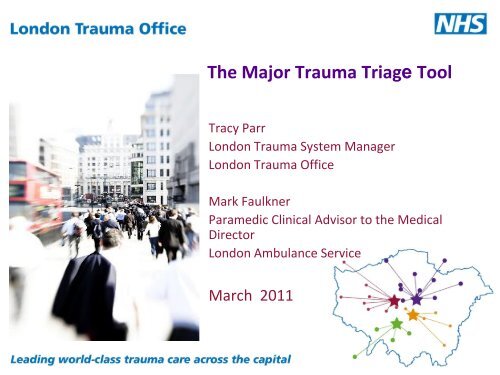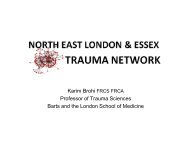The Major Trauma Triage Tool - London Trauma Office
The Major Trauma Triage Tool - London Trauma Office
The Major Trauma Triage Tool - London Trauma Office
You also want an ePaper? Increase the reach of your titles
YUMPU automatically turns print PDFs into web optimized ePapers that Google loves.
<strong>The</strong> <strong>Major</strong> <strong>Trauma</strong> <strong>Triage</strong> <strong>Tool</strong><br />
Tracy Parr<br />
<strong>London</strong> <strong>Trauma</strong> System Manager<br />
<strong>London</strong> <strong>Trauma</strong> <strong>Office</strong><br />
Mark Faulkner<br />
Paramedic Clinical Advisor to the Medical<br />
Director<br />
<strong>London</strong> Ambulance Service<br />
March 2011
<strong>Triage</strong><br />
<strong>Trauma</strong> triage refers to the process of sorting patients according to the kind of injury,<br />
severity of the injury and facilities available. “<strong>The</strong> ideal triage method would be applied<br />
quickly and easily under field conditions, give consistent results among different<br />
observers, and have a high rate of accuracy” (Eastman, 1987).<br />
<strong>The</strong> goal of a triage system is to consistently get the right patient<br />
to the right hospital in the right amount of time
Data Flow<br />
<strong>Major</strong> <strong>Trauma</strong> Centre<br />
Data Collectors<br />
Input comprehensive data for TARN<br />
analysis<br />
<strong>Trauma</strong> Audit & Research<br />
Network<br />
LTO with validated , but non-patient<br />
identifiable, data including ISS<br />
TARN criteria:<br />
All <strong>Trauma</strong> patients<br />
72 hours stay<br />
admitted high dependency<br />
die in the hospital<br />
transferred for specialist care<br />
or a high dependency bed<br />
Injuries meet the criteria<br />
<strong>Major</strong> <strong>Trauma</strong> Centre<br />
Emergency Department<br />
Completes spreadsheet of all blue<br />
light trauma patients<br />
<strong>London</strong> Ambulance Service<br />
Clinical Audit Research Unit<br />
Matches LAS data and MTC to provide<br />
complete list of <strong>Trauma</strong> Tree Positive<br />
Patients Identifies LAS record and tree<br />
triggers<br />
<strong>London</strong> <strong>Trauma</strong> <strong>Office</strong><br />
Matches TARN record with LAS CARU<br />
<strong>Trauma</strong> Tree Data<br />
<strong>London</strong> Ambulance<br />
Clinical Coordination<br />
Desk<br />
Collect & store pre-alert<br />
ambulance data<br />
Acknowledgements<br />
•<strong>London</strong> Ambulance Service<br />
•Clinical Co-ordination Desk<br />
•Clinical Audit & Research<br />
Unit<br />
•<strong>Trauma</strong> Audit & Research<br />
Network<br />
•<strong>London</strong> Health Observatory<br />
•<strong>Major</strong> <strong>Trauma</strong> Centres
<strong>Major</strong> <strong>Trauma</strong> <strong>Triage</strong> Tree
Map 1: All <strong>Trauma</strong> Tree Positive Patients 1 st April -<br />
31 st July
All <strong>Trauma</strong> Tree Positive Patients 1 st April -31 st July to<br />
Kings College MTC
All <strong>Trauma</strong> Tree Positive Patients 1 st April -31 st July to<br />
Royal <strong>London</strong> MTC
All <strong>Trauma</strong> Tree Positive Patients 1 st April -31 st July to<br />
St George's MTC
<strong>Triage</strong> <strong>Tool</strong> Triggers 1 ST June – 31 st July 2010<br />
Total <strong>Triage</strong> <strong>Tool</strong><br />
triggers,<br />
n=498<br />
Assessment of Vital Signs & Level of Consciousness<br />
(n=114, 23%)<br />
Assess Anatomy of Injury<br />
(n=227, 46%)<br />
Assess Mechanism of Injury (n=44, 9%)<br />
Assess Special Patient or System Consideration Cons. (n=11, 2%)<br />
CCD/HEMS/BASICS (n=41, 8%)<br />
Paediatric (n=58, 12%)
<strong>Major</strong> <strong>Trauma</strong> Decision Tree<br />
Step One
Assessment of Vital Signs & Level of Consciousness<br />
Vital Signs<br />
(n=114)<br />
GCS
Glasgow Coma Score<br />
GCS 15<br />
(n=46, 46%)<br />
ISS 9 to 15 (n=4, 4%)<br />
ISS 1 to 8 (n=4, 4%)<br />
Admitted - Not TARN eligible<br />
(n=34, 34%)<br />
Discharged (n=11, 11%)
Systolic Blood Pressure less than 90mmHg<br />
SBP 15<br />
(n=2, 22%)<br />
ISS 9 to 15<br />
(n=2, 22%)<br />
Admitted - Not TARN eligible<br />
(n=3, 33%)<br />
Discharged<br />
(n=2, 22%)
Respiratory Rate 29 breaths per minute<br />
RR 29<br />
(n=6)<br />
ISS 9 to 15<br />
(n=3, 50%)<br />
Admitted but not TARN eligible<br />
(n=2, 33%)<br />
Discharged<br />
(n=1, 17%)
<strong>Major</strong> <strong>Trauma</strong> Decision Tree<br />
Step Two
Assess Anatomy of Injury<br />
Anatomy<br />
(n=217)<br />
Altered chest physiology<br />
(n=18, 8%)<br />
Penetrating trunk trauma<br />
(n=141, 64%)<br />
Pelvic #<br />
(n=29, 13%)<br />
Spinal trauma with abnormal<br />
neurology (n=29, 13%)
Suspected Pelvic Fracture<br />
Suspected Pelvic Fracture<br />
(n=42)<br />
ISS >15<br />
(n=10, 23%)<br />
ISS 9 to 15 (n=4, 23%)<br />
ISS 1 to 8<br />
(n=10, 23%)<br />
Admitted - not TARN eligible<br />
(n=12, 28%)<br />
Discharged<br />
(n=6, %)
Penetrating Trunk Injuries<br />
Penetrating trunk trauma<br />
triggers (n=141)<br />
ISS >15 (n=11, 8%)<br />
ISS 9 to 15 (n=7, 5%)<br />
ISS 1 to 8 (n=5, 4%)<br />
Admitted - Not TARN eligible<br />
(n=56, 40%)<br />
Discharged<br />
(n=62, 44%)
Chest Injury With Altered Physiology<br />
Chest injury with altered<br />
physiology<br />
n=18<br />
ISS >15<br />
(n=8, 44%)<br />
ISS 9 to 15<br />
(n=3, 17%)<br />
ISS 1 to 8 (n=1, 6%)<br />
Admitted not TARN eligible<br />
(n=2, 11%)<br />
Discharged<br />
(n=4, 22%)
<strong>Major</strong> <strong>Trauma</strong> Decision Tree<br />
Step Three
Assess Mechanism of Injury<br />
Mechanism triggers<br />
(n=44)<br />
Bullseye windscreen and/or<br />
damage to ‘A’ post of vehicle<br />
(n=24, 52%)<br />
Falls >20ft (two storeys)<br />
(n=18, 43%)<br />
Trapped under vehicle (n=1, 2%)<br />
Assoc. fatality passenger compartment (n=1, 2%)
Bullseye windscreen / damage to ‘A’ post of vehicle<br />
Bullseye windscreen and/or<br />
damage to ‘A’ post of vehicle<br />
(n=24)<br />
ISS 9 to 15<br />
(n=3, 13%)<br />
Admitted - not TARN eligible<br />
(n=8, 33%)<br />
Discharged<br />
(n=15, 17%)
Fall more than 20ft (two storeys)<br />
Falls >20ft (two storeys) n=18<br />
ISS >15<br />
(n=7, 37%)<br />
ISS 9 to 15<br />
(n=2, 11%)<br />
ISS 1 to 8<br />
(n=2, 11%)<br />
Admitted - not TARN eligible (n=1, 5%)<br />
Discharged<br />
(n=6, 32%)
All MTCs <strong>Triage</strong> <strong>Tool</strong> Positive patients by time of admission<br />
06/04/10 to 31/05/10, n=541<br />
Number of patients<br />
45<br />
40<br />
35<br />
30<br />
25<br />
20<br />
15<br />
10<br />
5<br />
0<br />
1 2 3 4 5 6 7 8 9 10 11 12 13 14 15 16 17 18 19 20 21 22 23 24<br />
Hour of the day
Journey times (minutes) from scene of incident to<br />
arrival in MTC for triage tool positive patients<br />
May and June 2010 (n = 501)
All MTCs <strong>Triage</strong> <strong>Tool</strong> Positive patients<br />
06/04/10 to 31/07/10, n=1,088
Future Work<br />
o Expand data set<br />
o Work with <strong>London</strong> Health Observatory to<br />
undertake sensitivity and specificity of<br />
section of trauma tool<br />
o True negatives<br />
o <strong>The</strong>matic analysis of ISS >15 in <strong>Trauma</strong><br />
Units<br />
o Review tool
Thanks<br />
Mark.Faulkner@Lond-Amb.nhs.uk<br />
Tracy.Parr@<strong>London</strong><strong>Trauma</strong><strong>Office</strong>.nhs.uk



